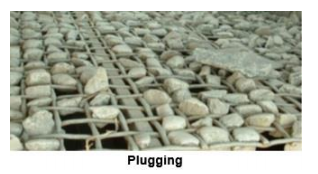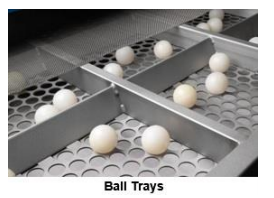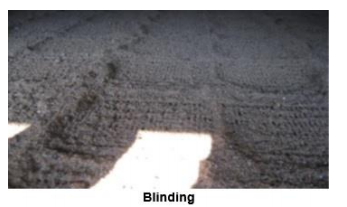

كما هو موضح في الشكل أعلاه، تتكون صواني الكرات من حجرات ذات لوحة مثقوبة أو قطعة قماش سلكية ذات فتحات كبيرة نسبيًا موضوعة أسفل قماش الشاشة. بشكل عام، يتم وضع كرات مطاطية في كل حجرة ترتد بحرية أثناء تشغيل الشاشة. فهي تضرب الجانب السفلي من سطح الشاشة وبالتالي تطرد المادة المسدودة بشكل عشوائي. إن الاهتزاز الثانوي المتولد في قماش الشاشة بسبب ضرب الكرات يمنع أيضًا الجزيئات الدقيقة من الالتصاق والتراكم على الأسلاك. في معظم الحالات، تكون صينية الكرات فعالة مع المواد التي تحتوي على ما يصل إلى 5% من الرطوبة. تمر المادة التي تمر عبر قماش الشاشة عبر اللوحة المثقبة أو القماش السلكي الموجود أسفل صينية الكرة حيث يمكن جمعها.
تُستخدم صواني الكرات بشكل عام للشبكات الخشنة التي يمكنها تحمل طاقة التأثير الأعلى من الكرات. لا يُنصح باستخدام الكرات لشبكات الشاشة الدقيقة لأنها قد تلحق الضرر بقماش الشاشة.

وكقاعدة عامة، يجب إجراء الفحص عند حجم فتحة أقل من حوالي 5 مم على مادة جافة أو مبللة تمامًا، ما لم يتم اتخاذ تدابير خاصة لمنع التعمية. يحدث التعمية عندما تتسبب الرطوبة في التصاق الجزيئات الدقيقة بالسطح وتغطية الفتحات تدريجيًا. وفي هذه الحالة قد يساعد تغيير السكتة الدماغية وزيادة السرعة. ويمكن أيضًا النظر في استخدام الوسائط السطحية المختلفة. الخيارات الأخرى هي النظر في صواني الكرة والطوابق الساخنة. تحتوي الأسطح المُدفأة على تيار كهربائي في السلك الذي يعمل على تسخين المادة وتجفيفها بحيث تتفكك بسهولة عندما تهتز الشاشة. يعد السطح المسخن طريقة أكثر فعالية لمنع عمى المواد الرطبة (1.5 إلى 6٪ رطوبة) من صينية الكرة.
يمكن استخدام محولات التسخين، التي تستهلك من 2 إلى 3 كيلو فولت أمبير لكل قدم من طول الشاشة، مع أي قطعة قماش شبكية تزن أقل من حوالي 1.5 رطل. للقدم المربع الواحد. يتدفق التيار بجهد منخفض (1 إلى 12) وأمبيرية عالية لإنتاج درجات حرارة على أسلاك الشاشة تتراوح من 80 إلى 150 درجة فهرنهايت. لا تهدف هذه الحرارة إلى تجفيف المادة التي يتم فحصها، ولكن فقط لتجفيف السطح البيني بين السلك والجسيمات الملتصقة (مثل جسيمات الطين) بشكل كافٍ لكسر الرابطة اللاصقة التي تربط الجسيمات بالسلك. اهتزاز الشاشة يقوم بالباقي.
يسمح الفحص الرطب بمعالجة الأحجام الدقيقة بكفاءة حتى 250 ميكرومتر وأدق.
يتم غسل الدقائق الملتصقة من الجزيئات الكبيرة، ويتم تنظيف الشاشة عن طريق تدفق اللب وبخاخات الماء الإضافية. يحدث الترحيل عندما تفشل الجزيئات الصغيرة جدًا في المرور عبر الفتحات. قد تتضمن الحلول تغيير السكتة الدماغية أو السرعة أو عكس دوران الشاشة؛ تغيير قطر السلك أو شكل الفتحة لزيادة المساحة المفتوحة؛ تغيير زاوية الميل وتغيير حمولة العلف.
العلامات :
اتصل بنا :
بريد إلكتروني : sales@vrvibratory.com شبكة IPv6 مدعومة
شبكة IPv6 مدعومة 